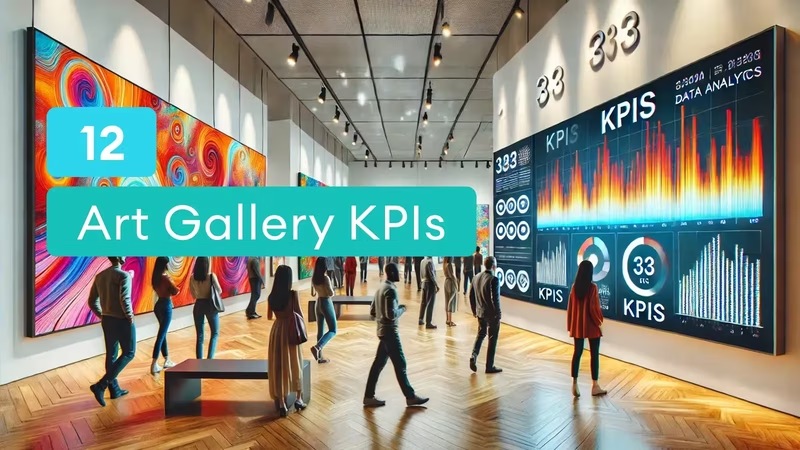Art is a challenging business
It's safe to say that the past few years for galleries have been a rollercoaster of fortunes. From keeping up with digital trends to managing social and economic pressures, art galleries have faced numerous unforeseen challenges. But here’s the good news: by tracking the right Key Performance Indicators (KPIs), you can turn these challenges into opportunities for growth and success!
First up, adapting to digital trends is no longer optional. As more people turn to online platforms to explore art, having a strong digital presence is crucial. Embracing digital engagement can expand your reach, attract new audiences, and keep your existing visitors returning for more.
Then there’s the elephant in the room: economic pressures. Financial challenges, like reduced funding and lower visitor numbers during economic downturns, can hit hard. But with the right KPIs, you can strategically manage resources and navigate these tough times, ensuring your gallery remains financially sound.
Let’s not forget about cultural shifts. Staying relevant in a rapidly changing cultural landscape is key to keeping your audience engaged. By staying ahead of trends and reflecting cultural changes in your exhibitions, you’ll keep your gallery buzzing with excitement.
And yes, resource constraints are real. Many galleries operate with limited staff and budgets, making it tough to implement and track KPIs. But don’t worry—tracking the right metrics doesn’t have to be overwhelming. With a focused approach, even small teams can leverage KPIs to make smarter decisions and drive success.
In this article, we’ll dive into 12 essential KPIs that every art gallery should track. These KPIs will help you overcome challenges, adapt to changes, and ensure your gallery thrives in today’s dynamic environment. Let’s get started!
The 12 Essential KPIs for Galleries
Visitor Count
- Description: Measures the total number of visitors to the gallery. This KPI helps gauge the popularity and reach of the gallery. Tracking visitor count can highlight trends in attendance and identify peak periods.
- Example: The Modern Art Gallery tracks its visitor count and notices an increase from 4,000 visitors in January to 5,500 visitors in February, possibly due to a popular new exhibition launched in mid-January.
- Formula: Visitor Count = Total number of visitors in a given period.
Artwork Sales Volume
- Description: Tracks the number of artworks sold. This KPI is crucial for understanding sales performance and inventory turnover.
- Example: The Contemporary Art Museum sells 30 pieces in March, up from 15 pieces in February, indicating a successful marketing campaign and a high-interest exhibition.
- Formula: Artwork Sales Volume = Total number of artworks sold in a given period.
Revenue from Art Sales
- Description: Measures the total revenue generated from selling artworks. This KPI helps in understanding the financial health of the gallery.
- Example: The Downtown Gallery earns $75,000 from art sales in April, attributed to a high-profile artist’s exhibit that attracted affluent buyers.
- Formula: Revenue from Art Sales = Sum of all sales revenue from artworks in a given period.
Average Artwork Sale Price
- Description: Calculates the average price at which artworks are sold. This helps in pricing strategy and assessing the market value of the artworks.
- Example: The Urban Art Center’s average sale price in May is $3,000, reflecting the sale of several high-value pieces and some lower-priced prints.
- Formula: Average Artwork Sale Price = Total Revenue from Art Sales / Number of Artworks Sold.
Exhibition Attendance Rate
- Description: Measures the attendance rate for specific exhibitions. This KPI helps in evaluating the success and appeal of exhibitions.
- Example: The National Gallery holds a Picasso exhibition with an attendance rate of 90%, indicating high public interest and effective promotion.
- Formula: Exhibition Attendance Rate = (Number of Exhibition Attendees / Total Capacity) * 100.
Customer Satisfaction Score
- Description: Evaluates the satisfaction level of visitors through surveys or feedback forms. This KPI is crucial for understanding visitor experience and areas for improvement.
- Example: After visiting the Impressionist Art Exhibit, 88% of visitors rated their experience as excellent, highlighting successful curation and presentation.
- Formula: Customer Satisfaction Score = (Number of Satisfied Responses / Total Survey Responses) * 100.
Average Visitor Spend
- Description: Measures the average amount spent by visitors, including tickets, merchandise, and donations. This KPI helps in maximizing revenue opportunities.
- Example: The Riverfront Gallery calculates that each visitor spends an average of $50, including entrance fees, café sales, and gift shop purchases.
- Formula: Average Visitor Spend = Total Revenue / Total Number of Visitors.
Membership Conversion Rate
- Description: Tracks the percentage of visitors who become members. This KPI is important for building a loyal visitor base and generating recurring revenue.
- Example: Out of 2,000 visitors in June, 200 sign up for an annual membership at the Art House, leading to a 10% conversion rate.
- Formula: Membership Conversion Rate = (Number of New Members / Total Number of Visitors) * 100.
Marketing ROI
- Description: Measures the return on investment for marketing campaigns. This KPI helps in evaluating the effectiveness of marketing strategies.
- Example: The City Gallery invests $3,000 in an online ad campaign that results in $12,000 in sales from new visitors, achieving a Marketing ROI of 300%.
- Formula: Marketing ROI = (Revenue Generated from Marketing - Marketing Cost) / Marketing Cost * 100.
Social Media Engagement Rate
- Description: Tracks engagement levels on social media platforms, including likes, comments, shares, and follows. This KPI is key for measuring digital presence and outreach.
- Example: The Gallery of Modern Art posts about a new exhibit and receives a 6% engagement rate on Instagram, indicating strong interest from their online audience.
- Formula: Social Media Engagement Rate = (Total Engagements / Total Followers) * 100.
Donations Received
- Description: Measures the total amount of donations received. This KPI helps in assessing the support and goodwill of patrons and donors.
- Example: The Heritage Art Gallery receives $5,000 in donations during a fundraising event, which will be used for future exhibitions and educational programs.
- Formula: Donations Received = Sum of all donations in a given period.
Exhibition Cost per Visitor
- Description: Calculates the cost of hosting an exhibition per visitor. This KPI is useful for budgeting and cost management.
- Example: The Classic Art Museum spends $20,000 on an exhibition that attracts 1,000 visitors, resulting in an Exhibition Cost per Visitor of $20.
- Formula: Exhibition Cost per Visitor = Total Exhibition Cost / Number of Exhibition Attendees.
Benefits of Art Galleries Introducing KPIs
Did you know that art galleries that leverage data analytics see a 20% increase in visitor engagement and a 15% boost in sales?
In today's fast-paced world, data is no longer just a tool for tech giants and financial firms; it's a game-changer for art galleries too! Whether you're curating a world-class exhibition or running a cozy local gallery, understanding and utilizing key performance indicators (KPIs) can transform your operations with the following benefits:
Enhanced Decision-Making
Tracking KPIs provides galleries with valuable data-driven insights. By analyzing these metrics, gallery managers can make informed decisions about various aspects of their operations. For example, understanding which exhibitions attract the most visitors can guide future curatorial choices. Additionally, KPIs related to sales and marketing effectiveness help galleries allocate resources more efficiently, ensuring that their strategies align with visitor interests and financial goals.
Improved Visitor Experience
KPIs like visitor satisfaction scores and engagement rates offer direct feedback on how visitors perceive their experience at the gallery. By monitoring these indicators, galleries can identify areas for improvement, such as enhancing exhibit layouts, offering better amenities, or providing more interactive elements. This focus on visitor experience not only boosts satisfaction but also encourages repeat visits and positive word-of-mouth, which are crucial for long-term success.
Financial Health Monitoring
Financial KPIs, such as revenue from art sales and average visitor spend, are essential for maintaining the gallery's financial stability. By regularly tracking these metrics, galleries can quickly identify trends and potential issues, such as declining sales or increased operational costs. This proactive approach allows galleries to adjust their financial strategies, optimize budgeting, and ensure sustainable growth even during economic downturns.
Marketing Effectiveness
KPIs related to marketing, like Marketing ROI and Social Media Engagement Rate, help galleries evaluate the success of their promotional efforts. By analyzing these metrics, galleries can determine which campaigns generate the most interest and convert the highest number of visitors. This information is crucial for refining marketing strategies, targeting the right audiences, and maximizing the impact of marketing budgets. Effective marketing not only drives visitor traffic but also enhances the gallery's brand presence and reputation.
Community Engagement
Tracking KPIs such as donations received and membership conversion rates provides insights into how well a gallery engages with its community. High levels of community support, reflected in donations and memberships, indicate strong relationships with patrons and local audiences. By understanding these metrics, galleries can tailor their outreach and engagement initiatives to foster deeper connections with their community. This engagement is vital for building a loyal supporter base, securing funding, and ensuring long-term sustainability.
By focusing on these key areas, art galleries can leverage KPIs to enhance their operations, improve visitor satisfaction, and achieve their strategic goals.
Conclusion
Tracking KPIs like visitor count, artwork sales volume, and social media engagement rate doesn't have to be daunting. With user-friendly tools and software designed for KPI tracking, even galleries with limited resources can monitor these metrics effectively. Platforms like SimpleKPI provide intuitive dashboards that simplify data collection and visualization, making it easy for your team to stay on top of performance indicators.
The future of art gallery KPIs is promising. As technology continues to advance, galleries can leverage more sophisticated data analytics and AI-driven insights to further enhance their operations. Expect to see more integration of virtual reality (VR) and augmented reality (AR) in tracking visitor engagement and satisfaction. These technologies will not only help in providing immersive experiences but also offer deeper insights into visitor behavior and preferences.
Moreover, the emphasis on digital presence will grow stronger, with KPIs related to online engagement and digital marketing becoming even more critical. Social media metrics, online sales, and virtual exhibition attendance will play a significant role in shaping gallery strategies.
In conclusion, embracing KPI tracking is essential for navigating the challenges faced by art galleries today. By focusing on the right metrics, you can make informed decisions, optimize your resources, and ensure your gallery thrives in a dynamic environment. So, start tracking those KPIs today and watch your gallery transform into a beacon of success in the art world!

by Stuart Kinsey
Stuart Kinsey writes on Key Performance Indicators, Dashboards, Marketing, and Business Strategy. He is a co-founder of SimpleKPI and has worked in creative and analytical services for over 25 years. He believes embracing KPIs and visualizing performance is essential for any organization to thrive and grow.
